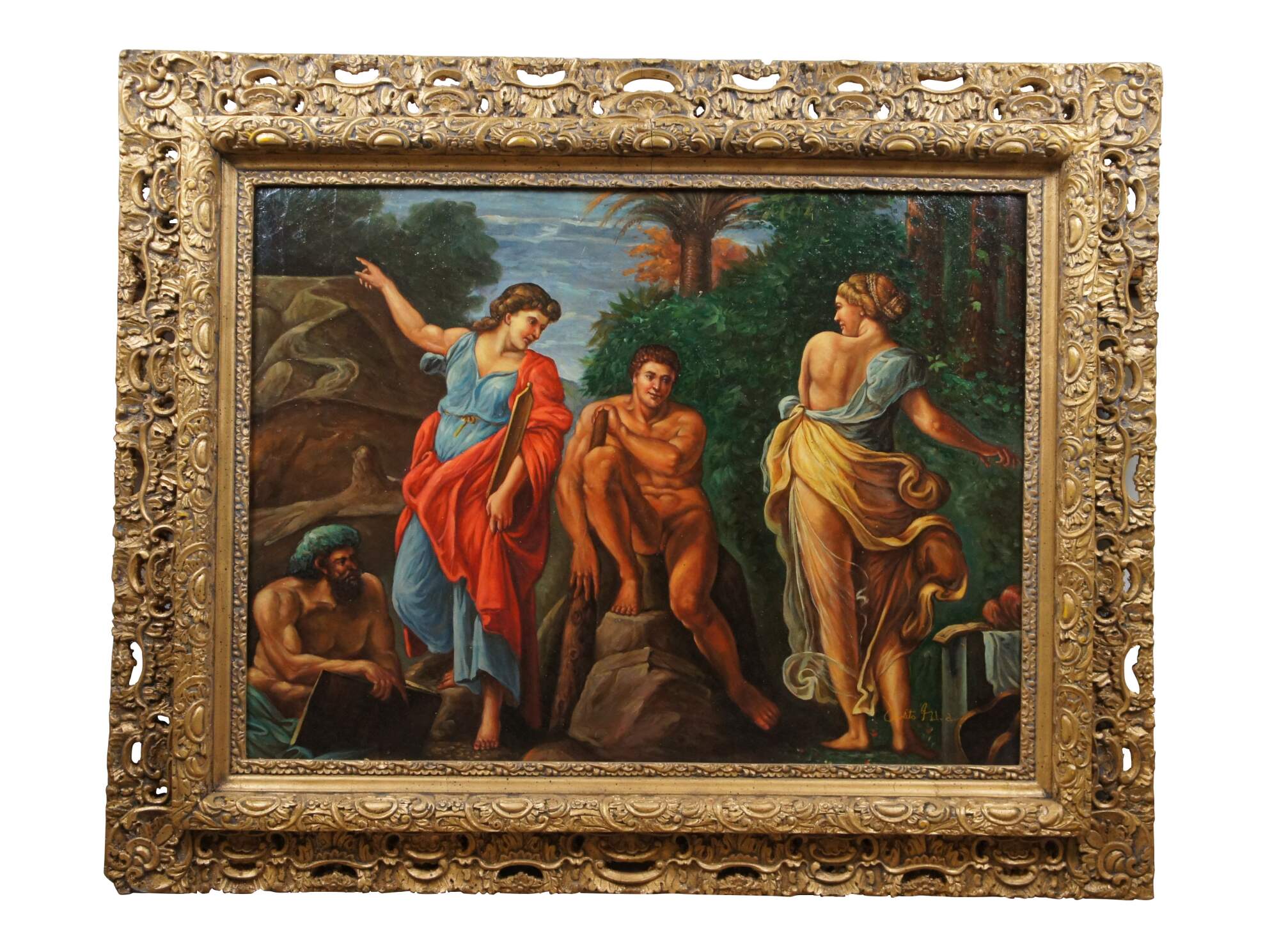
Shipping:
Free Shipping Included
Delivery:
Estimated 2-15 Business Days
Payments:
Credit Card, Check, Cash, PayPal, Apple Pay, Venmo
Returns:
30 Days 100% Money Back Guarantee, Buyer Pays Return Shipping
Description
Late 20th century oil painting on linen after "Hercules at the Crossroads" (also known as "The Choice of Hercules") by Annibale Carracci. Depicts the ancient Grecian hero Hercules with the personified figures of Pleasure, Virtue, and an un-named poet. Intricate pierced / molded resin floral and foliate frame with gold finish.
"Annibale Carracci‘s The Choice of Hercules, also known as “Hercules at the Crossroads,” is a significant painting that epitomizes the Italian Baroque period’s focus on dramatic themes, complex emotions, and moral narratives. Painted in the late 16th century (circa 1596), this work is housed in the Capodimonte Museum in Naples, Italy. The painting illustrates a moment from the life of Hercules, a hero from Greek mythology, who is faced with a choice between two paths in life: one of virtue and the other of vice. The narrative is derived from a story attributed to the ancient Greek sophist Prodicus, which became a popular theme for artists during the Renaissance and Baroque periods. In Carracci’s interpretation, Hercules is depicted as a young man at a crossroads, physically and metaphorically. He is approached by two female figures, each embodying the contrasting paths his life could take. On one side, Virtue is represented as a noble woman, modestly dressed, gesturing towards a steep and rocky path that leads upwards towards the heavens, symbolizing a life of hard work, integrity, and eventual spiritual reward. On the other side, Vice is depicted as an alluring woman, richly attired and adorned, inviting Hercules to follow a smooth and pleasant path that represents a life of ease, pleasure, and self-indulgence. Carracci’s composition masterfully contrasts the figures of Virtue and Vice, not only in their attire and posture but also in the symbolic landscapes that lie behind them. The painting is celebrated for its dynamic composition, the emotional complexity of Hercules as he contemplates his choice, and the detailed depiction of the figures and the landscape. Carracci’s use of color, light, and shadow enhances the drama and depth of the scene, drawing viewers into the moral quandary faced by Hercules. The Choice of Hercules reflects the Baroque era’s interest in depicting psychological depth and moral dilemmas, offering viewers not just a visual spectacle but also a contemplative experience. Through this painting, Carracci explores themes of morality, temptation, and the human condition, encouraging viewers to reflect on the choices they face in their own lives. The work is a testament to Carracci’s skill as a painter and his ability to convey complex narratives and emotional states through his art." (Source: The Digital Art World)
"Annibale Carracci (1560 - 1609) was active/lived in Italy. Annibale Carracci is known for Baroque religious genre and figure painting. Annibale Carracci was known as eclectic because he selected the things he most admired from the great artists before him and fused them into his own work. He was a fine artist in his own right and original enough to do this successfully. His many followers of lesser talent leaned so heavily upon their predecessors that the art of such eclectic painters fell into disrepute and eclecticism became a term of disgrace. Annibale was the youngest of three brothers who ran an academy of painters. Sons of a Bologna butcher, Ludovico (1555-1619) was the eldest and founder of the Academy. By preference he specialized in religious subjects. Agostino (1557-1602), trained first as a goldsmith, was witty, handsome and erudite. A superb draftsman, he excelled in etching and his paintings of broad-bottomed nudes are among the Carraci's best. Of all the family, Annibale, the youngest of the three, born in 1560, was easily the most talented. Silent and melancholy, he was absorbed in his work in later years. He died in Rome on July 14, 1609, mourned as having been "the greatest artist alive at that moment." He was forty-nine. A favorite anecdote of art historians has long been the answer that Caracci gave when asked which one had painted a picture. "I Caracci; we all had a hand in it." Written and submitted by Jean Ershler Schatz, artist and researcher from Laguna Woods, California." (Source: askART)
Condition
Good Overall - Gentle wear; some chips/cracks to frame
Dimensions
51.5" x 1.5" x 41.5" / Sans Frame - 39" x 29" (Width x Depth x Height)